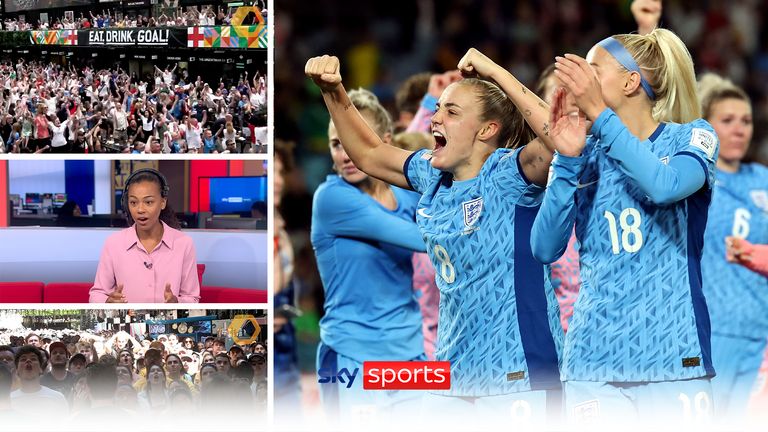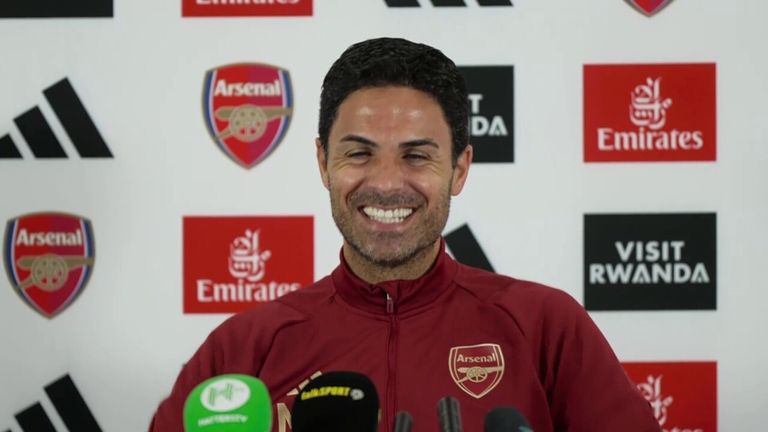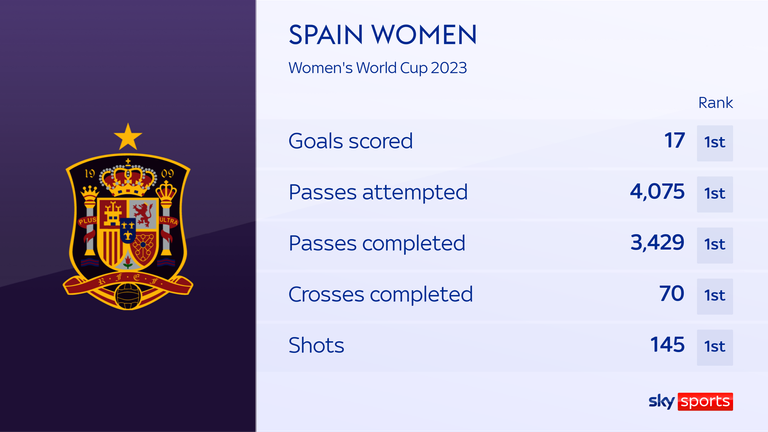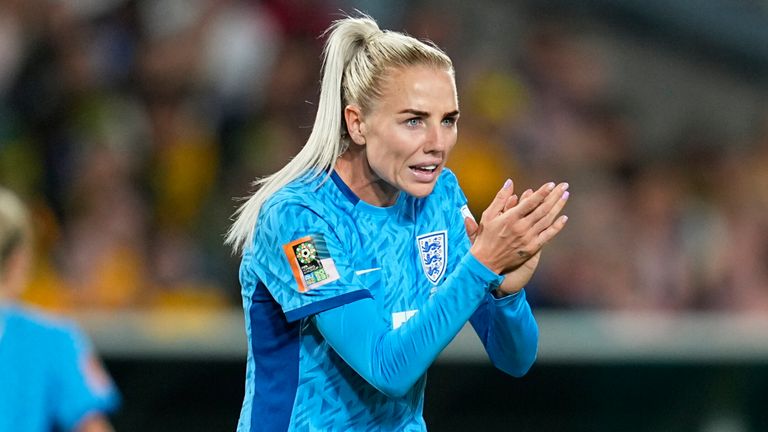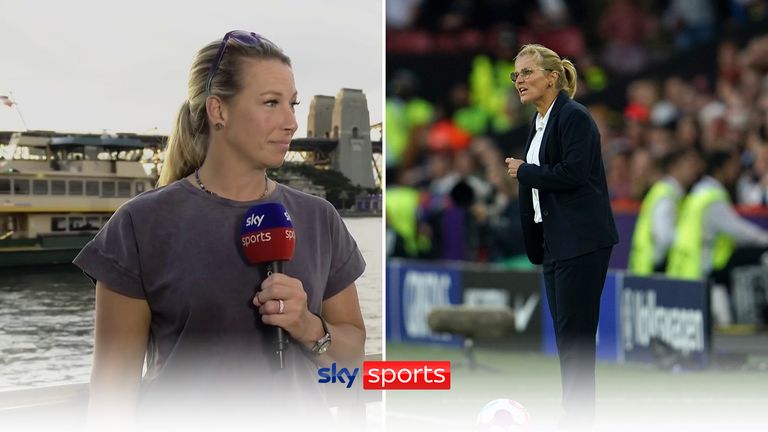Women's World Cup final: How England's tactical tweaks could stun Spain in Sunday's showpiece
Spain and England feature in their first Women's World Cup final this Sunday in Sydney; we examine the tactical tweaks the Lionesses could make to deal with their opponents; follow the final in our blog on Sunday, kick-off 11am
Sunday 20 August 2023 11:56, UK
England are within touching distance of World Cup glory, but what tactical tweaks need to be made against a formidable Spain side in Sunday's final?
The Lionesses sealed their spot in this weekend's showdown with a 3-1 win against co-hosts Australia, while Spain needed a last-minute winner from Olga Carmona to secure a 2-1 victory over Sweden.
If England are to fly home with the trophy, they will need to overcame a Spain side that pushed them to the brink of elimination before a dramatic 2-1 comeback victory in last summer's European Championships.
So what are La Roja's strengths and weaknesses, and how could they be defeated?
- Women's World Cup 2023: England face Spain in Sunday's final
- Sarina Wiegman: England have a fearless leader - time to prove it
- Stream the WSL and more on NOW for £26 a month for 12 months
Spain's preferred style of football
Spain prefer to set up in a familiar 4-3-3 shape, where they can rotate possession quickly and seamlessly transition from defence to attack.
A backline consisting of Olga Carmona, Laia Codina, Irene Paredes and Ona Batlle helps facilitate that with overlapping runs and inverted passes.
The midfield trio - comprised of Aitana Bonmati, Teresa Abelleira and Alexia Putellas - are capable of punishing England on the counter attack as they carry the ball forward with pace and power,
Jenni Hermoso, Alba Redondo, and Mariona Caldentey make up the front three and are inexorably tricky to mark, particularly Hermoso who can fluidly move into the No 10 position.
While the team's spine remains the same, head coach Jorge Vilda has given minutes to rising stars, and it's paid off. Levante's Redondo and 19-year-old Salma Paralluelo have made impressive contributions to the squad.
Where La Roja's strengths lie
Spain thrive in the half-spaces. It gives them the time to coax out the gaps, and they will widen the smallest cracks and run with it.
The flanks are a particular area of joy, primarily through overlapping bursts from their full-backs.
Batlle is one of the leading orchestrators, inverting her forward bursts to cause commotion on the left. Australia's Hayley Raso cultivated similar chaos for Lucy Bronze on several occasions in Wednesday's semi-final clash.
This pressurised Millie Bright to shift across and provide additional support, effectively stretching the entire backline and exposing more areas to exploit.
That England revert to a back four when on the defensive might not matter. The Spain wingers move the ball quickly, and Wiegman's back three will need to be savvy to any decoy measures.
Further up the field, there's always danger brewing, this time in the form of Bonmati and Hermoso. The pair like to stitch passes to each other in a blistering blur of dribbling.
La Roja's midfield moves as a single entity when slinging the ball around, creating small triangles of possession that aim to weed out the kinks and start a chain reaction further ahead - something that certain squad players benefit from more than others.
Caldentey and Redondo both warrant a mention. The former is able to drift in and out of midfield when needed, while the latter often becomes the main crossing target for full-backs operating on the left in attacking formations.
Given that Caldentey is thriving within Barcelona's league-winning setup, and Redondo is Europe's leading scorer, Wiegman will not want to leave anything to chance.
Neither Bright nor Jess Carter can afford to give away the ball so easily when playing out from the back, as they have done in brief blips across this tournament.
- Essential football podcast: Women's World Cup semi-final review as England beat Australia
- Spain 2-1 Sweden: Olga Carmona fires La Roja to first Women's World Cup final with late goal
Weaknesses in Vilda's approach to games
Japan provided the blueprint on how best to test this Spain side - and render them powerless.
They set up in a compact 5-4-1 system, which cut out La Roja's preferred attacking method of full-back overloads and tiki-taka passing.
The game unravelled precisely how Futoshi Ikeda had planned: four goals scored and not a sniff for their opponents, despite offering up 77 per cent of possession.
Every time Spain thrust themselves into the attacking foray, they left themselves exposed to a high line that did not reap any rewards.
A better side would have been able to foil Japan's master plan - and Sweden did that in the next game. But the path had already been laid.
So far, no other side has been able to replicate that success, nor has any other team been able to frustrate them so irrevocably on the ball.
Another area where Vilda's team have sometimes looked vulnerable is on corners and free-kicks, mainly because they need more physical prowess to stop opposing teams from benefitting aerially.
This is where England may be able to exploit their opponents. Alex Greenwood's set-piece delivery has been perfect throughout the tournament. Lauren Hemp and Alessia Russo were a constant threat behind the Australian defence, and another wicked cross could be just as damning for Spain.
- Australia 1-3 England: Lionesses make history as Lauren Hemp and Alessia Russo shine
- Sarina Wiegman describes reaching Women's World Cup final as "living in a fairytale"
How the Lionesses might be able to break through
When Wiegman spots a system working for her, she does not shy from it - even when key players return to the side.
A few weeks ago, when it seemed like Kiera Walsh might be out of the World Cup, Wiegman switched to a back three, with two holding midfielders as the central cover.
It worked so well that the shape stayed even when Walsh made her return, meaning the Lionesses could deploy two attackers up top in Russo and Hemp.
In Saturday's quarter-final against Colombia, the dynamic duo combined to orchestrate a 2-1 victory, cancelling out Leicy Santos' early goal.
Hemp bagged a goal with a poacher's finish while Russo fired in a powerful strike. Against Australia, they reversed roles and paved the path to Sunday's final.
Part of what makes this attacking set-up work is that while Russo is the physical centre-forward, she's still deft enough to make darting runs in behind, and while Hemp is the complex dribbler, she possesses a strength that makes her incredibly difficult to mark. It's unpredictable, adaptive, and hard to combat.
The next opportunity to showcase that will be against a team who likes to hoard possession and operate in a mid-block.
But as the Lionesses proved against Colombia, there's always a way in - and once you are in, the opportunity to make history is only ever a kick away.
Follow the Women's World Cup final on Sky Sports
Follow all the build-up, in-game coverage and post-match analysis from Spain vs England across Sky Sports' digital platforms on Sunday; kick-off 11am.
You can also follow the latest from Australia and New Zealand on Sky Sports News with Anton Toloui, Gail Davis plus much more.

